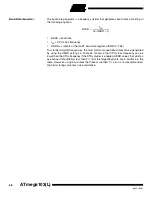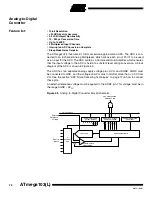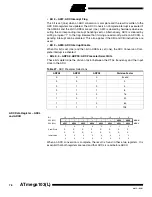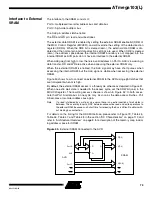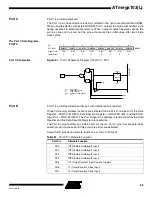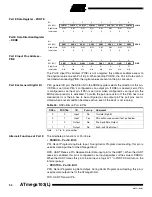
82
ATmega103(L)
0945G–09/01
to be cleared (zero) or the pin has to be configured as an output pin. The port pins are
tri-stated when a reset condition becomes active, even if the clock is not running.
Note:
n: 7,6...0, pin number
Port A Schematics
Note that all port pins are synchronized. The synchronization latch is, however, not
shown in the figure.
Figure 53.
Port A Schematic Diagrams (Pins PA0 - PA7)
Port B
Port B is an 8-bit bi-directional I/O port with internal pull-ups.
Three I/O memory address locations are allocated for Port B, one each for the Data
Register – PORTB, $18($38), Data Direction Register – DDRB, $17($37) and the Port B
Input Pins – PINB, $16($36). The Port B Input Pins address is read-only, while the Data
Register and the Data Direction Register are read/write.
All port pins have individually selectable pull-up resistors. The Port B output buffers can
sink 20 mA and thus drive LED displays directly. When pins PB0 to PB7 are used as
Table 28.
DDAn Effects on Port A Pins
DDAn
PORTAn
I/O
Pull-up
Comment
0
0
Input
No
Tri-state (high-Z)
0
1
Input
Yes
PAn will source current if ext. pulled low.
1
0
Output
No
Push-pull Zero Output
1
1
Output
No
Push-pull One Output
DA
T
A BUS
D
D
Q
Q
RESET
RESET
C
C
WD
WP
RD
RP
MOS
PULL-
UP
PAn
R
R
WP:
WD:
RL:
RP:
RD:
SRE:
A:
D:
W:
R:
n:
WRITE PORTA
WRITE DDRA
READ PORTA LATCH
READ PORTA PIN
READ DDRA
EXT. SRAM ENABLE
ADDRESS
DATA
WRITE
READ
0-7
DDAn
PORTAn
SRE
SRE
R
R
Dn
Dn
W
W
An
An
RL

